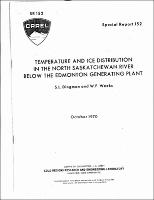Please use this identifier to cite or link to this item:
https://hdl.handle.net/11681/11935| Title: | Temperature and ice distribution in the North Saskatchewan River below the Edmonton Generating Plant |
| Authors: | Dingman, S. L. Weeks, W. F. |
| Keywords: | Inland waterways Rivers Stream pollution Thermal pollution Ice River ice Temperature Temperature measurement Steam electric power generation North Saskatchewan River (Alta. and Sask.) Edmonton (Alta.) |
| Publisher: | Cold Regions Research and Engineering Laboratory (U.S.) Engineer Research and Development Center (U.S.) |
| Series/Report no.: | Special report (Cold Regions Research and Engineering Laboratory (U.S.)) ; 152. |
| Description: | Special Report Abstract: A field study in a thermally polluted reach of the North Saskatchewan River at Edmonton, Alberta, was organized in December 1968, to test a previously developed method of predicting river temperatures due to thermal pollution sources. It was hoped to 1) investigate lateral mixing of heated water; 2) determine the relation between an ice front and the zero-degree isotherm; 3) measure water-surface heat-loss rates and relate them to meteorological conditions; and 4) determine the relation between meteorological conditions immediately over the river and those recorded at official stations nearby. Lateral mixing was found to be relatively fast, the entire cross section was heated only 1.45 km below the heat source, which is on the left bank. The ice front was located up stream of the zero isotherm when ice jams, caused by fluctuating river levels, formed in channel constrictions. At other times, the zero isotherm was several km upstream of the ice front, but this relation may have been affected by additional thermal pollution below the main source. Frazil ice formed continuously in an open reach above the main (and farthest upstream) thermal pollution source. The heat loss due to the melting of this ice-in the heated reach could not be estimated, but it may have been sufficient to account for the fact that the actual heat loss was six times greater than the calculated. Meteorological measurements in the valley of the North Saskatchewan River showed air temperatures about 2°C colder than at the official station on the plain 50 m above the river. Windspeeds were also considerably lower in the valley than on the plain, and there were significant differences in windspeeds depending on valley orientations. Several operational problems encountered in the course of the field work are discussed. |
| Rights: | Approved for public release; distribution is unlimited. |
| URI: | http://hdl.handle.net/11681/11935 |
| Appears in Collections: | Special Report |
Files in This Item:
| File | Description | Size | Format | |
|---|---|---|---|---|
| SR-152.pdf | 4.31 MB | Adobe PDF |  View/Open |